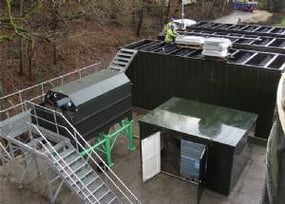We’re on LinkedIn!
Connect with WCS Environmental Engineering Safe Efficient Compliance

A rising demand for paper products for the hot beverage industry, along with the introduction of new paper processing techniques, has led Union Papertech to extend wastewater treatment at a Lancashire papermill.
Increased production at the mill, together with the water-saving papermaking processes, was expected to increase biological oxygen demand (BOD) concentrations, taking them above current permissible discharge levels. In addition to increased production, Union Papertech wanted better efficiency in their wastewater treatment.
Effluent had to be treated to a standard that meant it could be discharged safely into the local watercourse, the River Roach. Water used in the production process is also extracted from the river, so recycling the treated wastewater back into the local environment where it originally came from is the ideal solution.
The discharge consent standard had to be 45mg/l suspended solids and 45mg/l biochemical oxygen demand. The consultant spent four to five months investigating various technologies available that would fit the requirement.
In partnership with Patrick Nolan Consulting we recommended a HiPAF-SAF which would achieve 50% of BOD and SS in order to provide safety margins, additionally:
Ursula Kepp of Patrick Nolan Consulting said, “Analysing a number of potential solutions, I concluded that the solution was the best to accommodate expected variations in effluent concentration and volume at a comparable small footprint.”
The HiPAF-SAF treatment system is biological. This means that in order to work effectively, bacteria needs to grow inside the unit to break down and process the wastewater.
Bacteria need nutrients and air to thrive. In this particular case, the nutrients have to be added to the process, so a dosing system is used to incorporate the right nutrients. Air is supplied by diffuser into each segment of the biozone from blowers housed in a separate kiosk.
The new plant extension has been installed downstream of the existing dissolved air floatation (DAF) treatment plant and comprises three steel SAF units in parallel streams. A flow splitter is used to separate the incoming flow into three streams.
After treatment, the flow is combined again for tertiary treatment. Any remaining suspended solids are removed using a Microscreen before being discharged into the Roach. A walk-in kiosk houses the system controls and is easily accessible for monitoring.
With nutrient neutrality requirements being enforced at off-mains properties in areas of England, homeowners need to ...
Why managing variable loads matters If you have an off mains wastewater treatment system operating at a hospitality, ...
Trade effluents are liquid waste streams discharged into public sewers from businesses and industrial processes. Their ...
Connect with WCS Environmental Engineering Safe Efficient Compliance
WCS Group is a trading name for WCS Environmental Ltd, registered in England and Wales (Number 02184649) at 20 Grosvenor Place, London, SW1X 7HN. Head Office – 17 Wheatstone Court, Waterwells Business Park, Gloucester, GL2 2AQ. WCS Group is a Marlowe Critical Services Company owned by Marlowe plc. 2025© WCS Environmental Ltd.